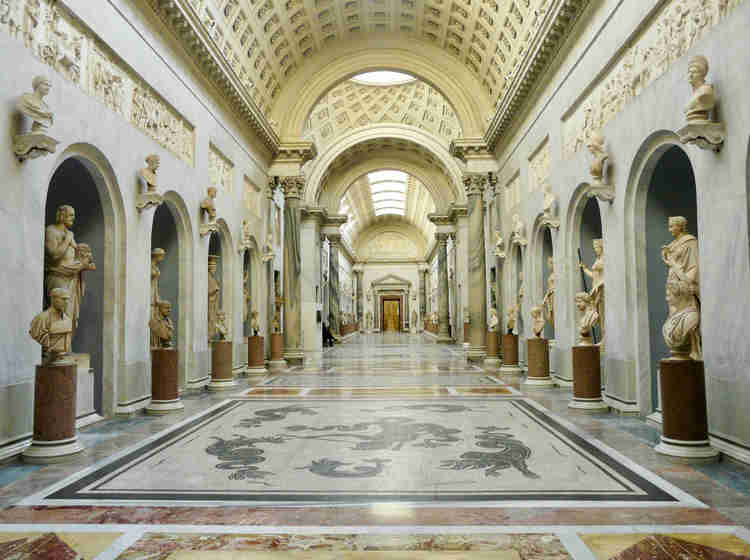
Are you a fan of ancient sculpture visiting Vatican City? If you want to know what to see, here’s my guide to 20+ must see sculptures in the Vatican Museums.
The Vatican holds one of the world’s greatest art collections in 26 museums. Some of the most famous art works on the planet are there, including magnificent ancient sculptures.
You’ll find these sculptures in the the Pio-Clementine Museum, the Chiaramonti Museum, Braccio Nuovo, the Gregorian Egyptian Museum, the Gregorian Etruscan Museum, and the Gregorian Profano Museum.
The Pio-Clementine Museum is on the main museum path. And you’ll stroll through it on any standard tour. But the other museums are a slight, but very worthwhile, detour off the main route.
Roman Sculpture
The history of the Roman Empire is chronicled, in part, by its statues and sculptures. The ancient Romans had a commitment to public art. It often served as political propaganda for an emperor or commemorated military victories.
READ: History of the Roman Emperors
Roman sculpture was heavily influenced by Greek sculpture. Today, many iconic Greek works we know from history only survive in Roman copies. Romans made thousands of copies of Greek sculptures. They didn’t believe that a copy was of any less value than the original.
Greek sculptures were always highly idealized with smooth lines, elegant drapery, and perfect bodies. The Greeks showed people as they should be, not as they were. Romans incorporated this classicizing style to a significant degree.
But Roman sculpture often took the form of portraiture. Roman statues have personality. They have a verisimilitude and look like the person they depict. They often reflected the fashions of the day in hair and clothing.
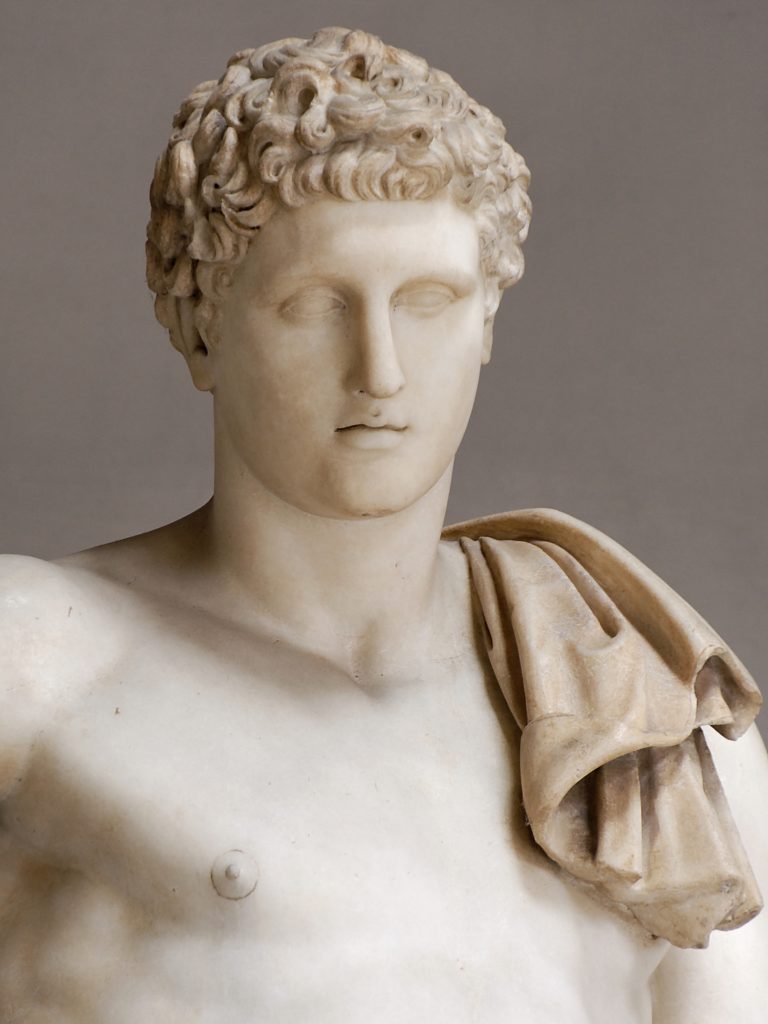
We don’t know today who made the Roman sculptures. Artists weren’t considered important in Ancient Rome. They only became revered during the Renaissance. Thus, there is no documentary evidence about the talented Roman artists. They remain anonymous.
Overview of Vatican Sculpture Museums
Opened in 1932, the Pio-Clementine Museum is the oldest art collection in the Vatican Museums. It houses ancient Greek and Roman sculptures from the collection of Pope Julius II. There are 10 rooms, each dedicated to a single theme.
The heart of the museum is the Octagonal Court, designed by the Renaissance architect Bramante, and the Round Hall. These spaces house the Vatican’s most famous sculptures. The Round Hall has an elaborate mosaic floor and its dome mimics that of the Pantheon.
The Chiaramonti Museum is almost as important as the Pio-Clementine Museum. But it gets less attention. Set in a long loggia, the museum was founded by Pope Pius VII. The famous Neo-Classical sculptor Antonio Canova was the curator beginning in 1807.
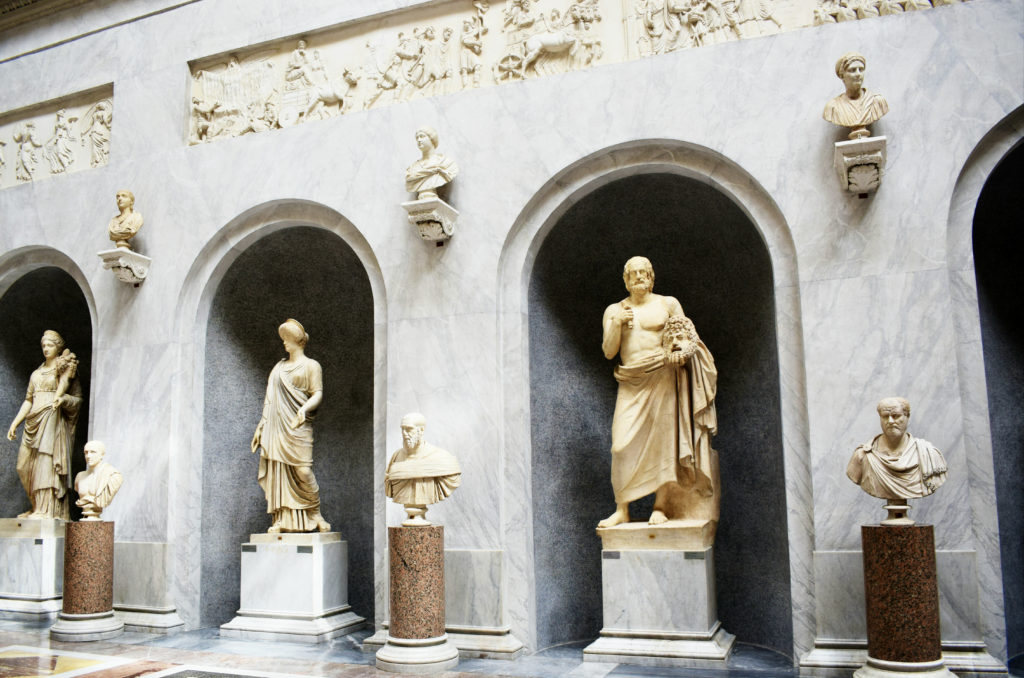
The Chiaramonti Museum has three parts: the original museum (in a Bramante-designed gallery); the New Wing (Braccio Nuovo); and the Gallery of Inscriptions.
The Gregorian Etruscan Museum was the first museum to be founded by Pope Gregory XVI. It opened in 1837. This museum holds the Vatican’s Etruscan works of art. The Etruscans were dominant in the Italian peninsula before Ancient Rome.
The Gregorian Egyptian Museum also owes its existence to Pope Gregory XVI, who had a passion for all things Egypt. The museum’s 9 room collection was drawn from various Roman and Italian collections at such places as the Villa Borghese, the Villa Farnesina, and Hadrian’s Villa in Tivoli.
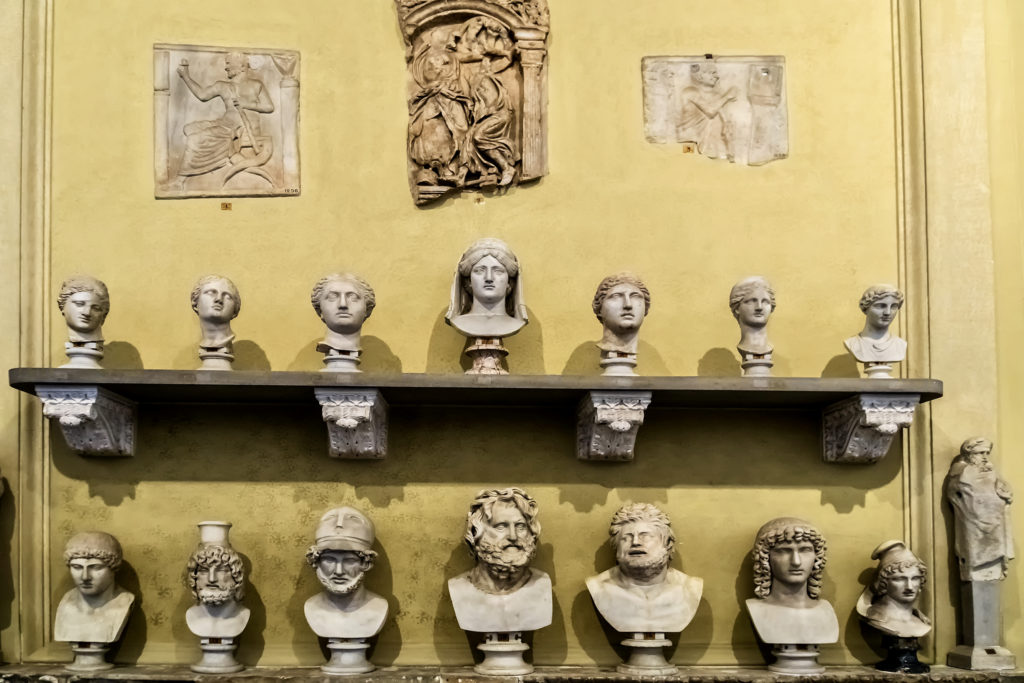
The Gregorian Profano Museum is housed in a light-filled modernist gallery. It was built in 1970 to showcase ancient works that had been in storage for decades. The museum has a special focus on objects from Roman antiquity that concern the world of politics and culture.
Famous Sculptures At The Vatican
The Vatican Museums are literally overflowing with antique statues. But what to be sure to see among the hundreds of sculptures?
Here are my picks for the 20+ must see sculptures in the Vatican Museums. I give you an overview of the sculpture and tell you where to find it in the Vatican Museums.
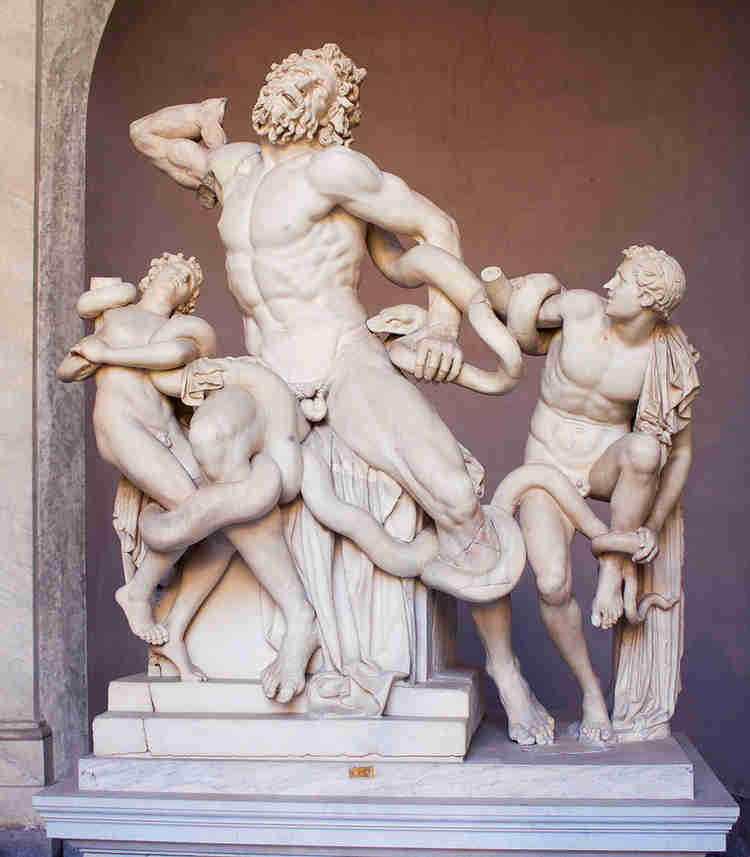
1. Laocoön and His Sons, Octagonal Court, Pio-Clementine Museum
Laocoön is one of the world’s most ancient and valuable sculptures. This Vatican sculpture was famously unearthed near Santa Maria Maggiore in 1506.
The statue was believed to have once decorated the palace of Emperor Titus. After the fall of the Roman Empire, Laocoön was lost for a millennium.
Upon its discovery, Michelangelo pressed for its restoration and urged Julius II to purchase it. It became the first work of art displayed at the Vatican.
Laocoön was initially lauded as the 2nd century B.C. Greek sculpture described by the classical author Pliny the Elder. But Laocoön is most likely a 1st century Roman marble statue copied from the bronze Greek original. Laocoön is revered for its technical mastery and emotionally evocative rendering.
Laocoön is based on an ancient Greek myth. In it, the priest Laocoön and his sons are attacked by a serpent sent by either Poseidon or Athena.
This was to punish Laocoön for exposing the Trojan Horse trick to his fellow Trojans, thereby angering the Greeks. To no avail, the three figures desperately try to untangle themselves from the serpent.
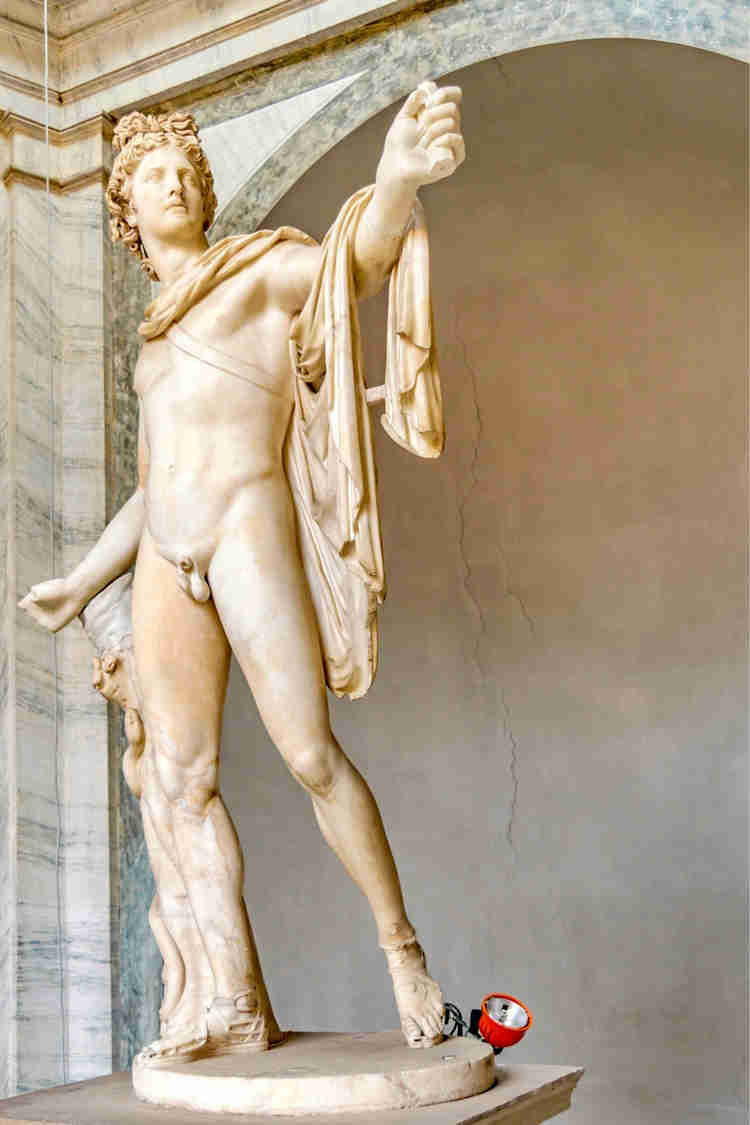
2. Apollo Belvedere, the Octagonal Court, Pio-Clementine Museum
Apollo Belvedere is one of antiquity’s most famous sculptures. It’s a Roman copy of Leochares’ bronze original from the 2nd century. Critics recognized it as Roman because Apollo is wearing distinctively Roman sandals.
The larger than life marble sculpture shows the god Apollo in a martial pose, having just shot an arrow. He may originally have been carrying one. The work is anatomically realistic and brilliantly executed. Apollo Belvedere is considered the epitome of masculine beauty and athleticism.
Apollo Belvedere was discovered around 1485. It was later acquired by Giuliano della Rovere, a great art collector, who became pope Julius II. Apollo Belvedere is praised as the “highest artistic ideal of all the works of antiquity.”
In 1511, Apollo Belvedere was placed in the Octagonal Court, where Julius II displayed his classical statues. Except for a 20 year period when Napoleon swiped the statue and hauled it to the Louvre in Paris, Apollo Belvedere has always been in the Vatican Museums.
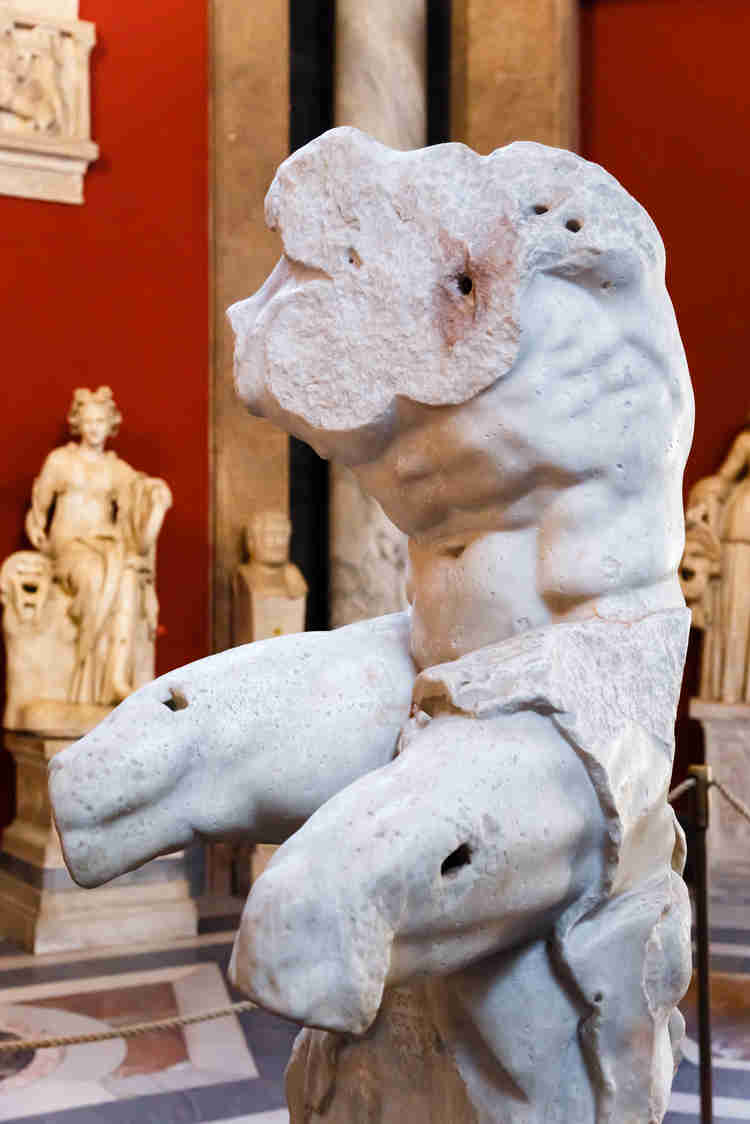
3. Apollonius of Athens, Belvedere Torso, Pio-Clementine Museum
This celebrated fragment of a damaged male nude statue is perhaps the most famous sculpture in the Vatican. It’s one of the museum’s only original Greek sculptures. Like Laocoon, the Belvedere Torso was hugely influential to Renaissance artists such as Michelangelo and Raphael.
The statue is said to have inspired Michelangelo’s Creation of Adam in the Sistine Chapel. What inspired these 16th and 17th century artists most was the twisted, convoluted quality of the statue.
Discovered in the 15th century, the marble sculpture itself dates back to the 1st century BC. The statue is signed on the base by “Apollonius, son of Nestor, Athenian.”
The man depicted? The most favored hypothesis is that it’s the Greek hero and demigod Hercules. But other theories say the sculpture is Ajax, possibly contemplating suicide, or a mythical athlete.
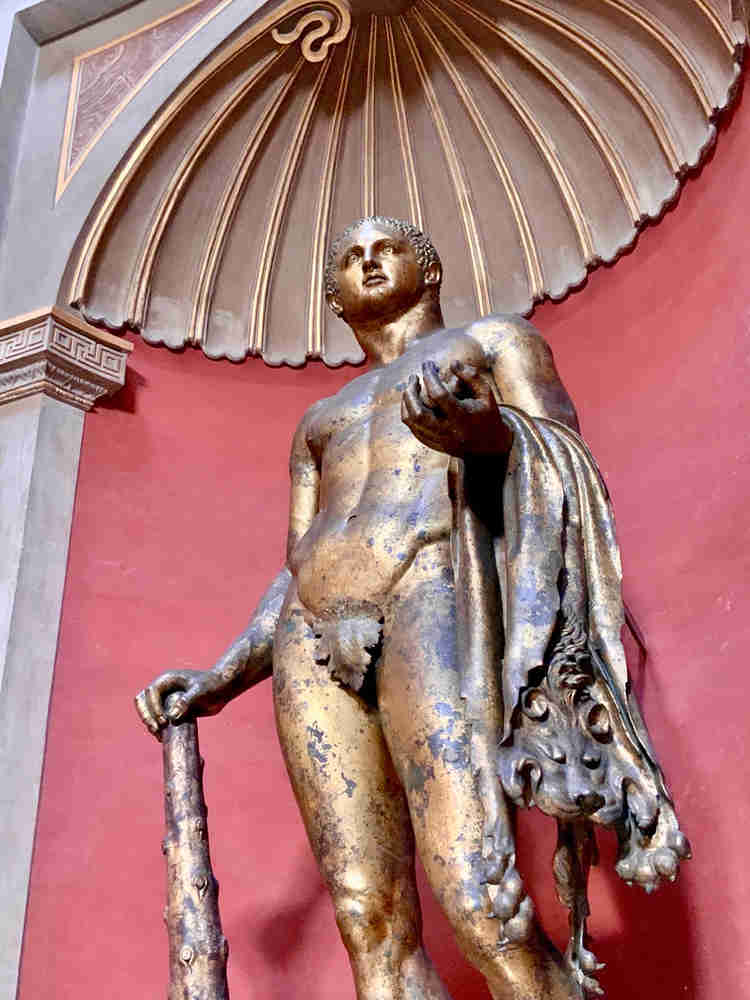
5. Colossal Statue of Hercules, Round Room, Pio-Clementine Museum
To find an ancient statue in bronze is truly a gift. So many of them that were melted down by the Romans back in the day to recycle the metal.
Hercules is one of the most famous sculptures in the Vatican. It’s a gilded statue with big eyes staring at you and curly hair. Archeologists found the statue in 1864 under a courtyard near Campo de’ Fiori.
The statue was then given to Pope Pius IX, which is why it’s in the Vatican today. Hercules is easily identifiable due to the Nemean lion skin wrapped over his arm, the club he is resting on, and the apples of the Hesperides in his left hand.
The statue dates somewhere from the 1st to 3rd centuries A.D. Historians believe it was copied from the Neo-Attic style popular in the 4th century B.C.
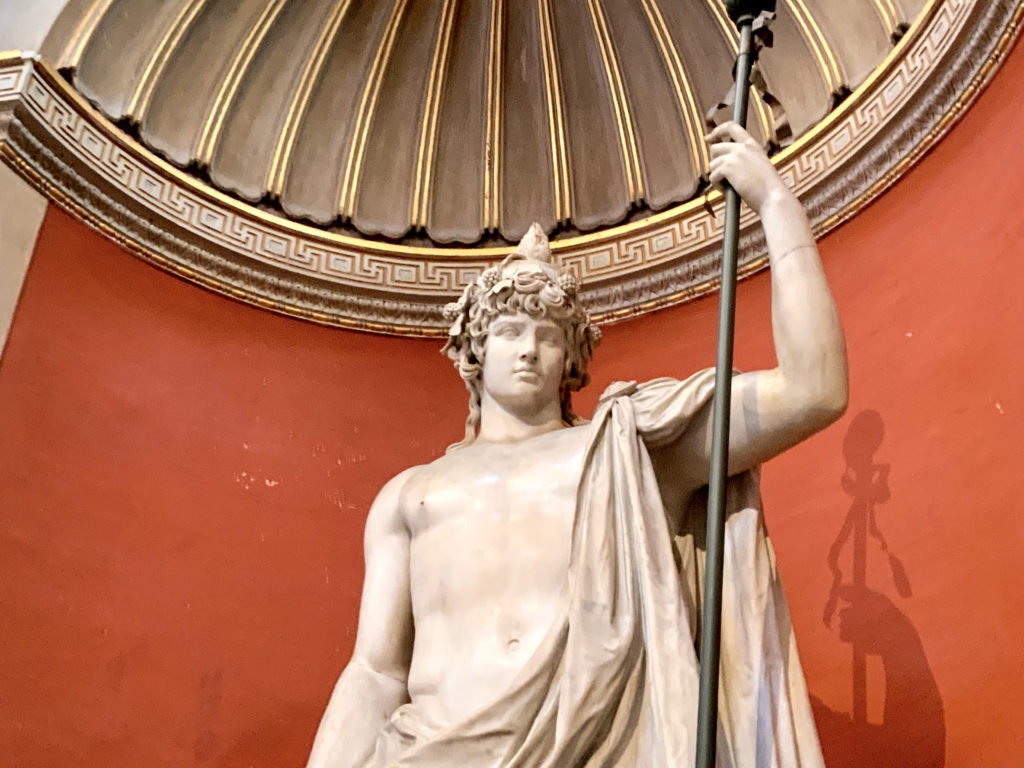
6. Braschi Antinous, Round Hall, Pio-Clementine Museums
This colossal ancient statue is known as the Braschi Antinous. It was discovered at Palestrina outside Tivoli and restored by Giovanni Pierantoni. The statue was exhibited in the Palazzo Braschi in Rome until 1844, hence its title.
Antinous was the favorite lover of the Emperor Hadrian. Legend holds that Antinous was around 12 years old (a little creepy!) when he caught Hadrian’s eye. Hadrian fell madly in love with him and made Antinous his constant companion.
Antinous drowned, under mysterious circumstances, in the Nile River in 130. Hadrian was devastated by the loss and immediately deified the youth.
In this colossal statue, Antinous appears as a god. His head is crowned with leaves, ivy, berries, and a diadem. He holds a staff topped with a pine cone, which is a modern addition.
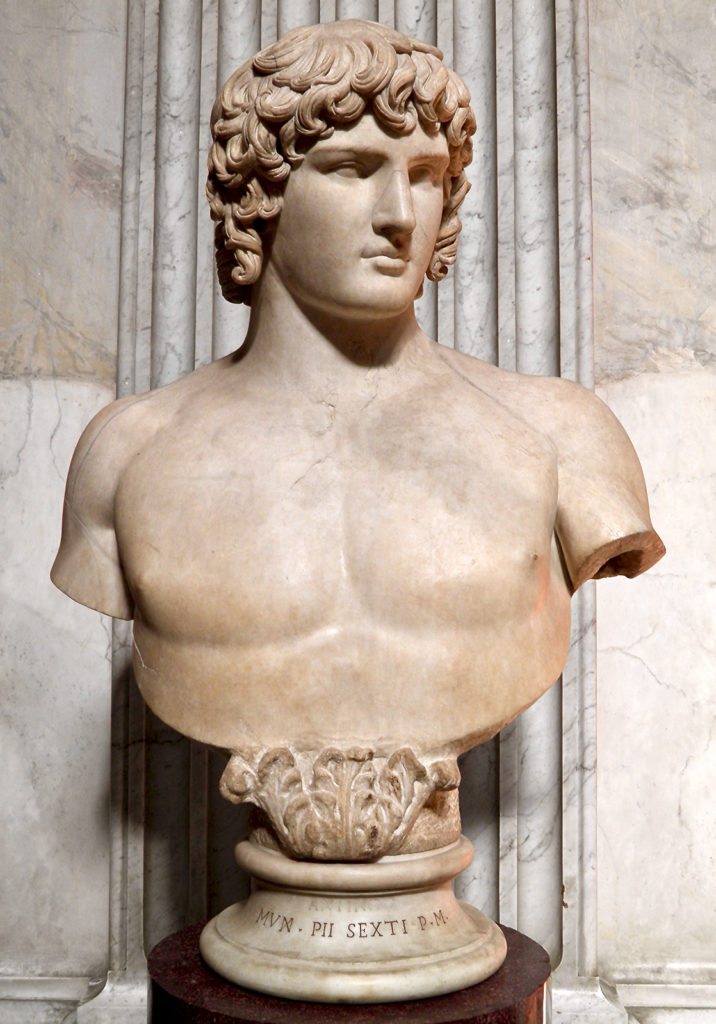
7. Bust of Antinous, Chiaramonte Museum
This is another Vatican sculpture created in tribute to Antinous.
The bust was discovered at Hadrian’s Villa in Tivoli in 1790. Emperor Hadrian loved everything Greek. He commissioned hundreds of roman copies of original Greek statues.
This bust conforms to the image of Antinous as a handsome young god. He’s naked with curly hair and idealized features.
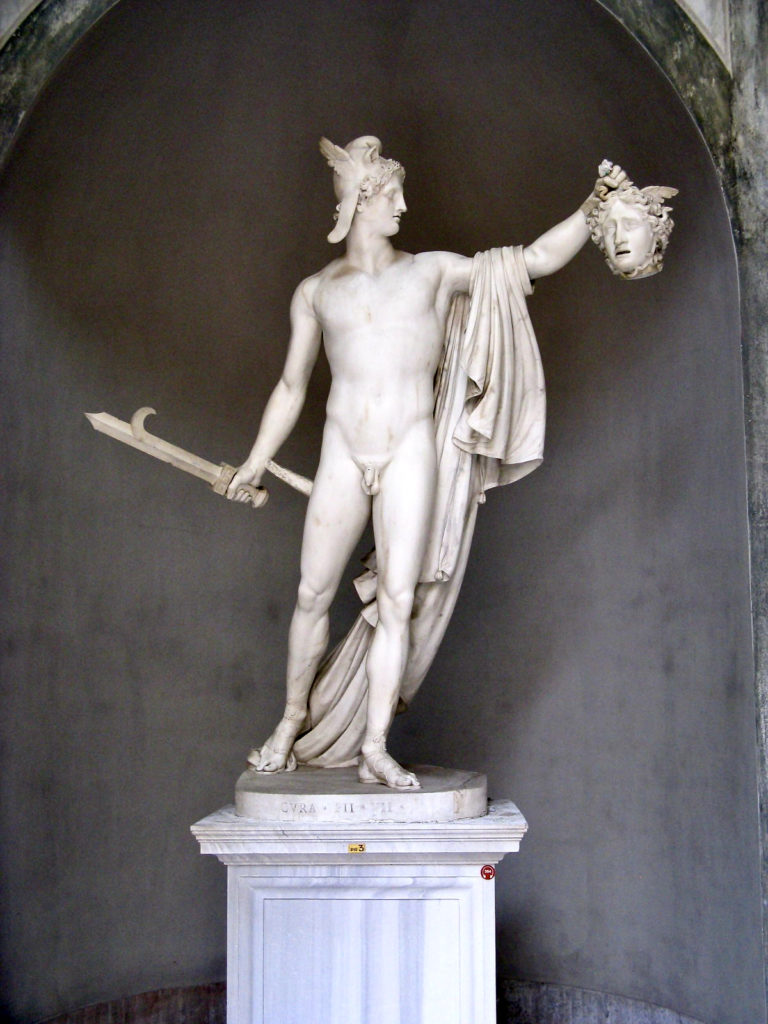
7. Perseus, Octagonal Courtyard, Pio-Clementine Museum
Another famous sculpture in the Vatican Museums is this beautiful 19th century marble statue by Antonio Canova, Perseus Triumphant. It shows the Greek demigod Perseus holding the snake-y head of Medusa.
Perseus stands in a triumphant pose, having just beheaded Medusa. The face of Medusa is a mask of horror.
Perseus wears the sandals of the Roman messenger god Mercury, which enabled him to fly. Perseus also wears the cap of Hades, which could made him invisible.
Perseus holds a harpe sword, owned by Zeus. He stands in a contrapposto, counterweight, stance. This creates a sense of movement in the statue.
The statue was heavily inspired by Apollo Belvedere. At the time, Apollo Belvedere had been carried off to Paris by a thieving Napoleon. Canova’s Perseus was bought by Pope Pius VII and placed upon the pedestal where the Apollo had formerly stood.
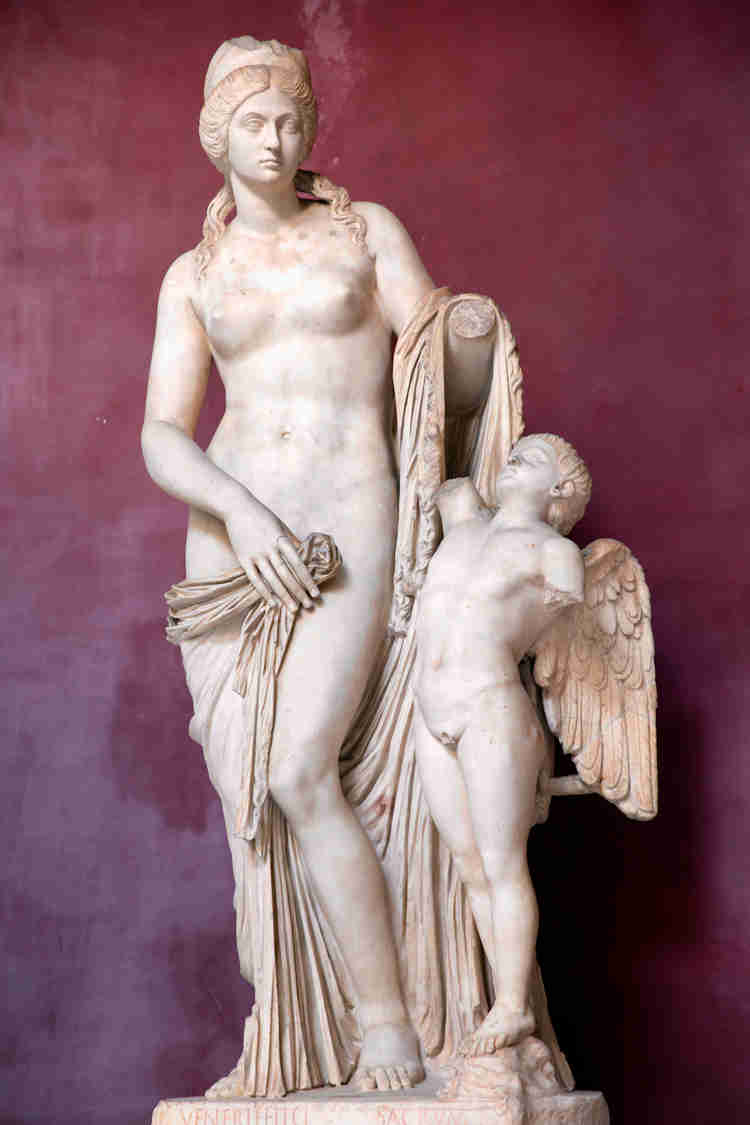
7. Venus Felix, Pio-Clementine Museum
Venus Felix means Good Fortune. The famous Vatican sculpture is a work of classical beauty. Venus stands in a contrapposto stance. A finely draped cloth covers her lower body, a sign of virginity.
Venus Felix is modeled after an ancient Greek sculpture, the Cnidian Aphrodite, by Praxiteles. That statue was believed to be the first life-sized realistically modeled female nude in Classical Greek art.
Next to Venus stands a winged Cupid. The sculptural group functioned as a votive figure. It was likely once in one of Rome’s temples dedicated to Venus.
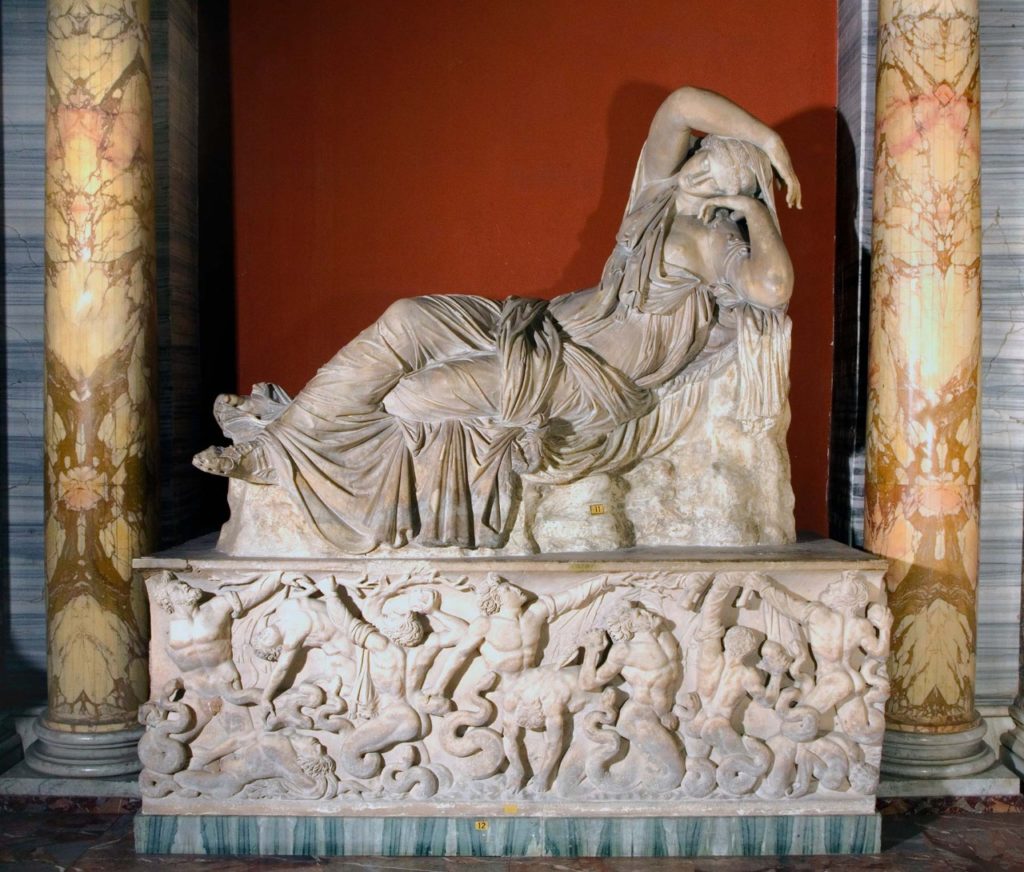
8. Sleeping Ariadne, Pio-Clementine Museum
Sleeping Ariadne is another must see sculpture in the Vatican Museums. It’s 2nd century Roman copy of a Hellenistic sculpture from the 2nd or 3rd century BC. The original is lost, and may have been of marble or bronze.
So who is this sleeping beauty? Ariadne is the daughter of the Cretan king Minos.
She helps her love Theseus triumph over the half-bull, half-human Minotaur. The genius behind the plan, Ariadne gives Theseus the string that helped him escape the labyrinth after slaying the monster.
The pair become engaged and Theseus takes Ariadne with him back to Athens. On the way, Ariadne is abandoned by an ungrateful Theseus and falls asleep on the island of Naxos. She’s found by the god Dionysus, who instantly falls in love and marries her.
The Vatican sculpture captures that key moment, when Theseus has gone and before Dionysus wakes her. Ariadne is vulnerable and alluring. Viewers are put in the position of Dionysus discovering her.
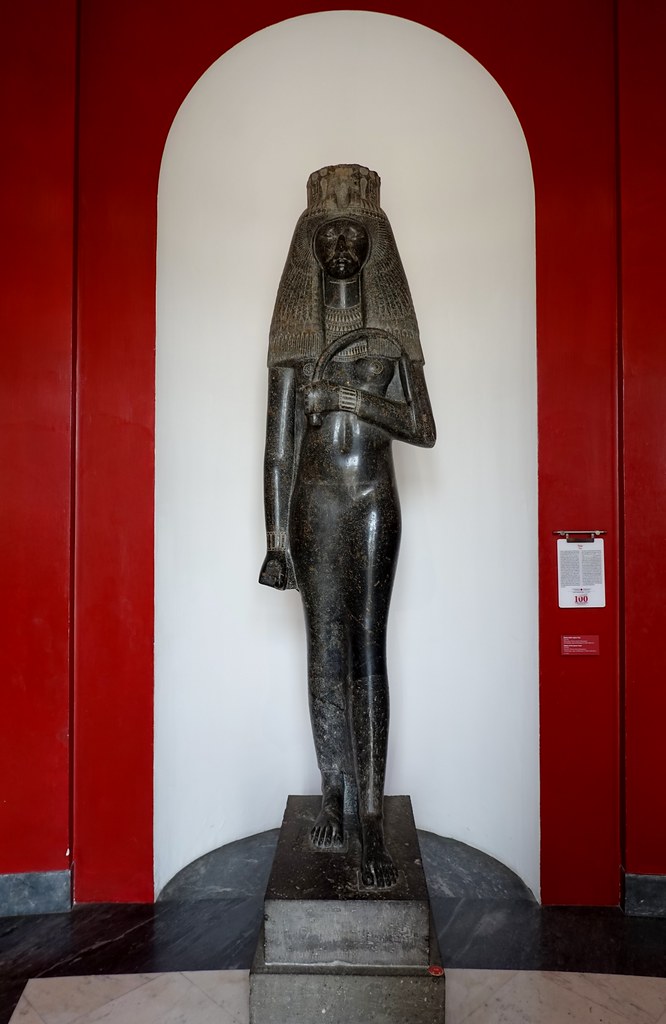
9. Colossal Statue of Queen Tuya, Gregorian Egyptian Museum
This statue comes from the reign of King Ramses II of Egypt. Tuya was the consort of Pharaoh Seti I and the mother of the renowned Pharaoh Ramses II. Ramses ruled during a period when the arts and architecture blossomed.
The statue is made of black granite. Tuya wears a long close fitting gown. The statue once had gold trim along the dress’ neck and cuffs.
In her left hand, Tuya holds a short whip, which alludes to the pharaohs status as the supreme shepherd. In her right hand, she holds a papyrus scroll, symbolizing nobility.
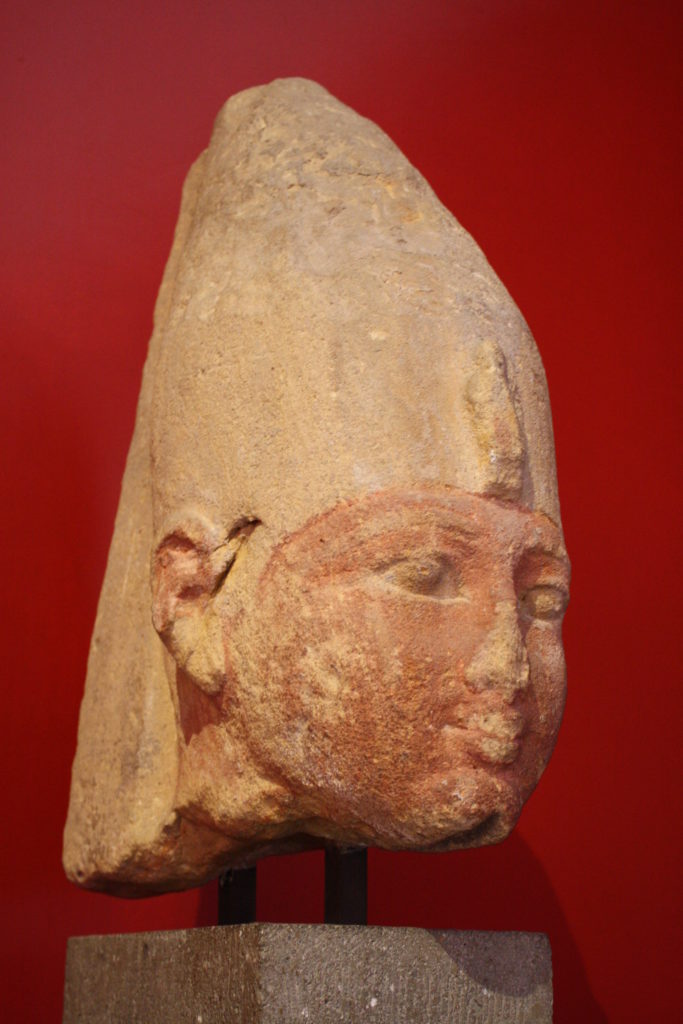
10. Head of Pharaoh Mentuhotep II, Gregorian Egyptian Museum
This limestone bust is the oldest sculpture in the Vatican Museums. It dates from 2050 B.C. The bust is identified as Pharaoh Mentuhotep II by an inscription on the back. Originally, the bust was thought to be part of a large statue.
The bust is an outstanding example of ancient Egyptian portraiture. The head has a lifelike facial expression.
As with other Egyptian statues, the face was painted red and you can still see traces of paint. The pharaoh wears the tall crown of the rulers of upper Egypt.
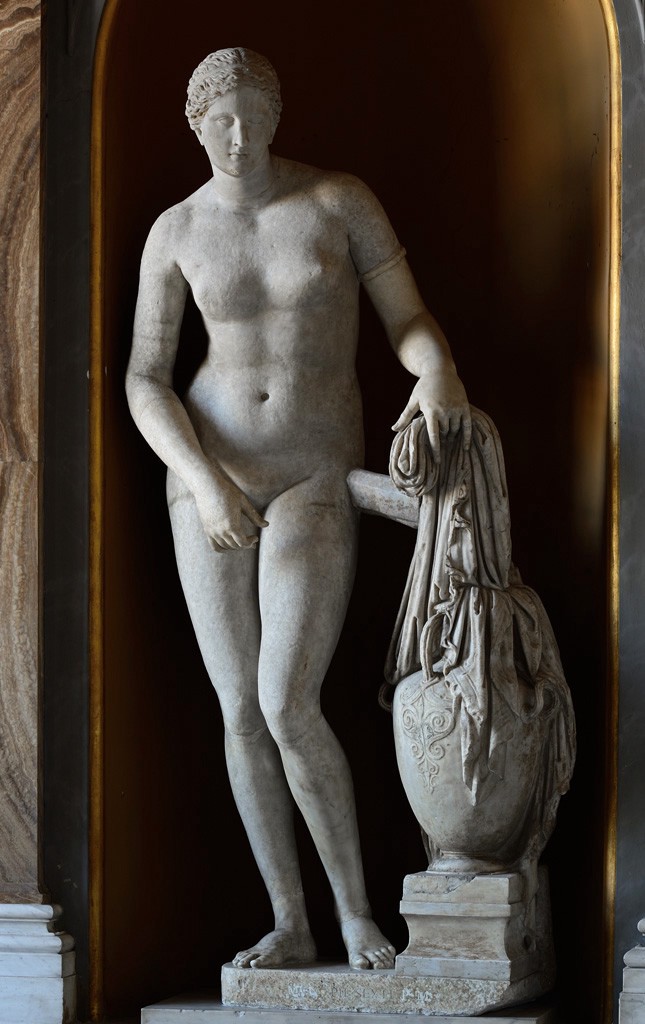
11. Colonna Venus, Pio-Clementine Museum
The Colonna Venus is the best known Roman copy of the Aphrodite of Cnidus, the famous Greek sculpture by Praxiteles that I mentioned above.
The historian Pliny writes that Praxiteles created two equally priced statues of Aphrodite: one was clothed and the other was not. The people of Cos preferred the clothed Aphrodite. The Cnidians purchased the nude statue, which was a hit.
The original and the Roman copy are noted for their classical beauty and harmony. For centuries, artists studied the ancient Greek statue. Its “S” shape is still considered the best-portrayed body of all time.
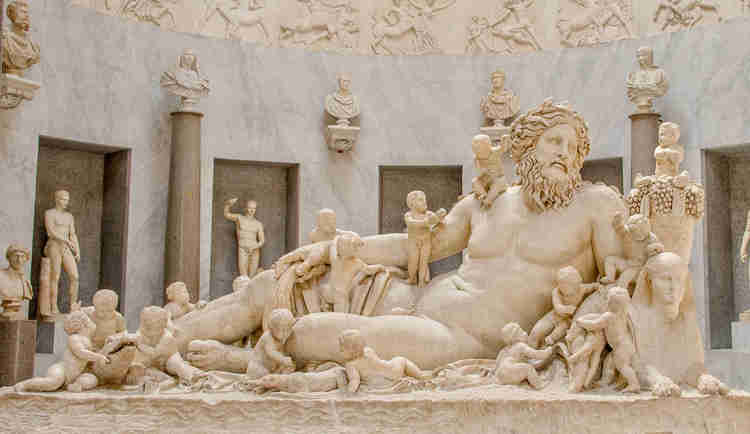
12. The River Nile, Braccio Nuovo
This monumental piece is one of the largest sculptures in the Vatican Museums. It was discovered near the Pantheon and the Basilica of Santa Maria Sopra Minerva. It may have been part of the valuable series of statues in a sanctuary created by the Emperor Domitian.
The statue is an allegory of the Nile River. The old man Nile is propped up by a sphinx. He wears a wreath of wheat, reeds, and lotus blossoms. These attributes symbolize the fertility bestowed by the river.
What distinguishes this sculpture from others of the same kind are the 16 putti and small animal figures clamoring onto the Nile figure.
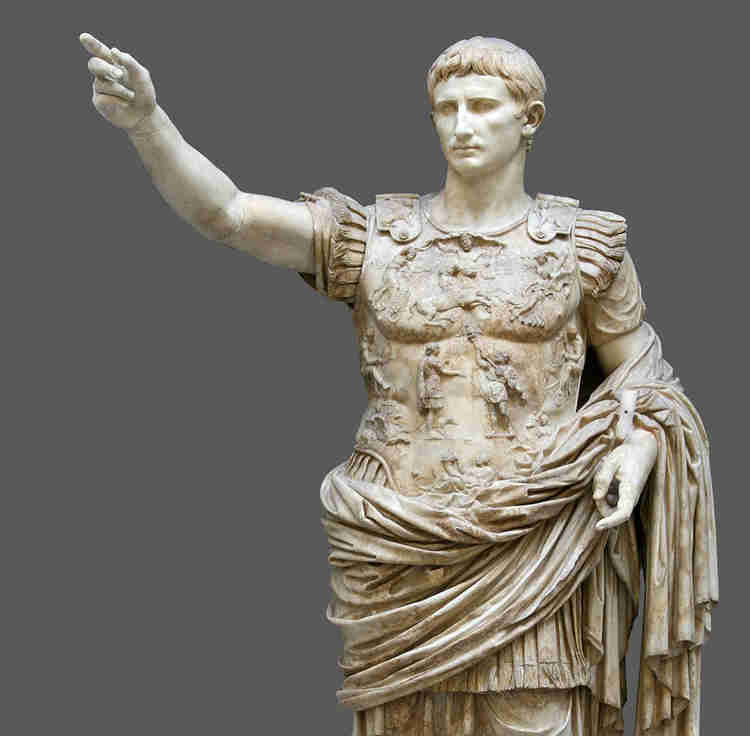
13. Augustus of Prima Porta, Braccio Nuovo
Augustus of Prima Porta is a 6.5 foot high marble sculpture of Emperor Augustus in the Vatican Museums. It was discovered on April 20, 1863 during excavation of the ruins of the Villa of Livia (Augustus’ wife) on Palatine Hill. She retired there after his death.
The statue dates from the 1st century. It’s likely a copy of an earlier sculpture from 20 B.C., which celebrated Augustus’ victory over the Parthians.
The Prima Porta is definitely one of the most important extant statues of Emperor Augustus. The sculpture is beautifully decorated and expertly carved in marble from the Greek island of Paros.
Likely a propaganda piece, the statue exudes power and resolution. A young Augustus is in full military dress, with a highly decorated breastplate and contrapposto pose.
A cloak is draped around his hips. Augustus carries a baton, raised in his right hand, as if he’s addressing troops. Augustus is shown barefoot, typical of the depiction of a god. To reinforce the connection to divinity, Cupid sits at Augustus’ right ankle.
Despite a few breaks, the statue is virtually fully intact. It’s now one of the most iconic images of the Roman Empire’s first emperor, who was a master of visual propaganda.
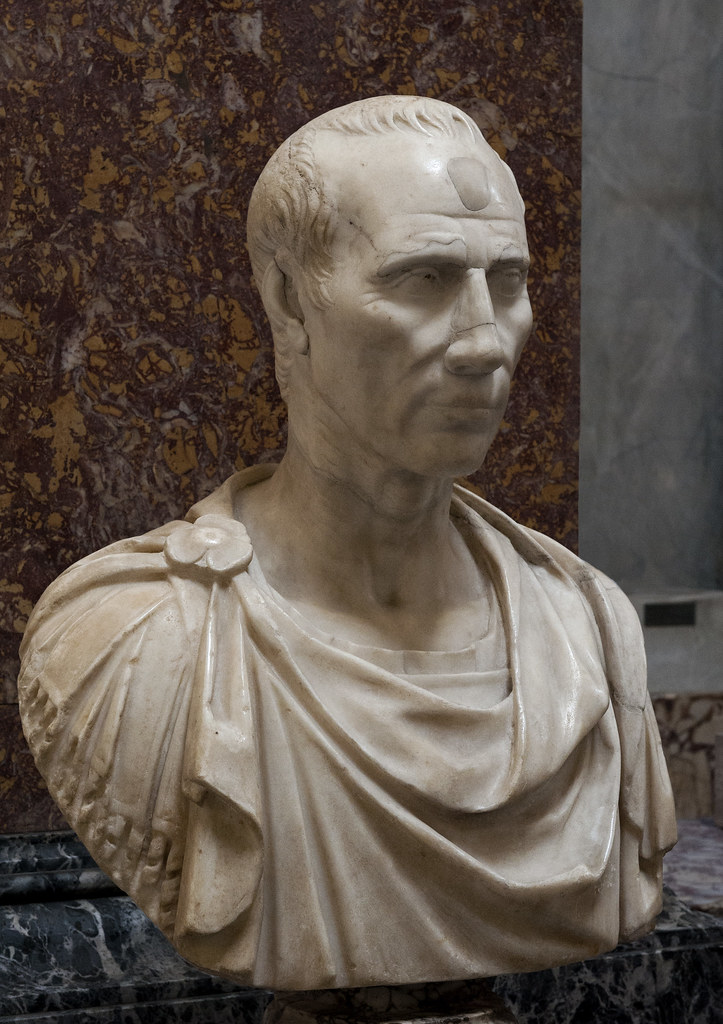
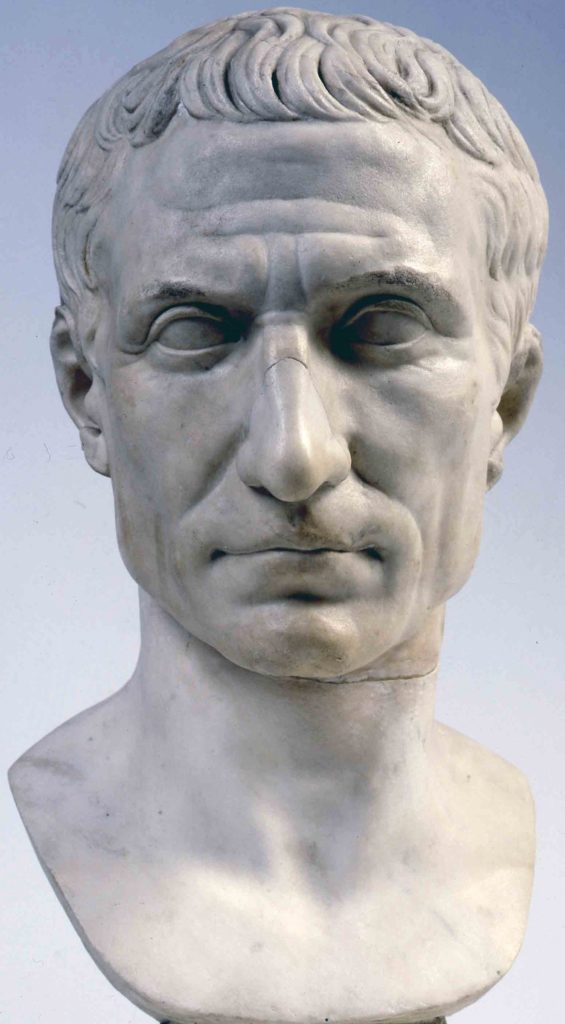
14. Busts of Julius Caesar
Julius Caesar was the first Roman leader to engineer the widespread replication of his image. His portraits were intended to promote the power and visibility of a single ruler.
The problem is that there are no known surviving busts that have been definitely authenticated as Julius Caesar. And there is no modern technologically that can pinpoint an image of Caesar. Classicists are mostly left with a description of Caesar’s physical appearance from the historian Suetonius.
These Vatican busts are fairly classic representations of the physiognomy of Julius Caesar described in writings. In the realistic renderings, the famous dictator looks resolute and determined.
The forehead is high and the eyes are large and close to his eyebrows. He has high cheekbones and a “vulturine” neck with lines.
The bust on the right is in the Gregory Profano Museum. It’s called the Chiarmonti Caesar because it was displayed in that museum for a long time.
15. Statue of Claudius As Jupiter, Round Hall, Pio-Clementine Museum
This is an over-life-size (8’ 4”) marble sculpture of Emperor Claudius in the Vatican. It was discovered in Tivoli in 1865. The statue was likely sculpted early in Claudius’ reign, around 42 or 43 A.D.
The statue joins the body of a young man with the head of a man who assumed the throne at age 50. It depicts Claudius in the guise of the Roman god Jupiter. You can tell by the oak crown, the scepter in his left hand, and the eagle (Jupiter’s sacred animal) at his feet.
The incongruity of an old man’s face on a young body was common in Roman art, especially when the image was used as propaganda.
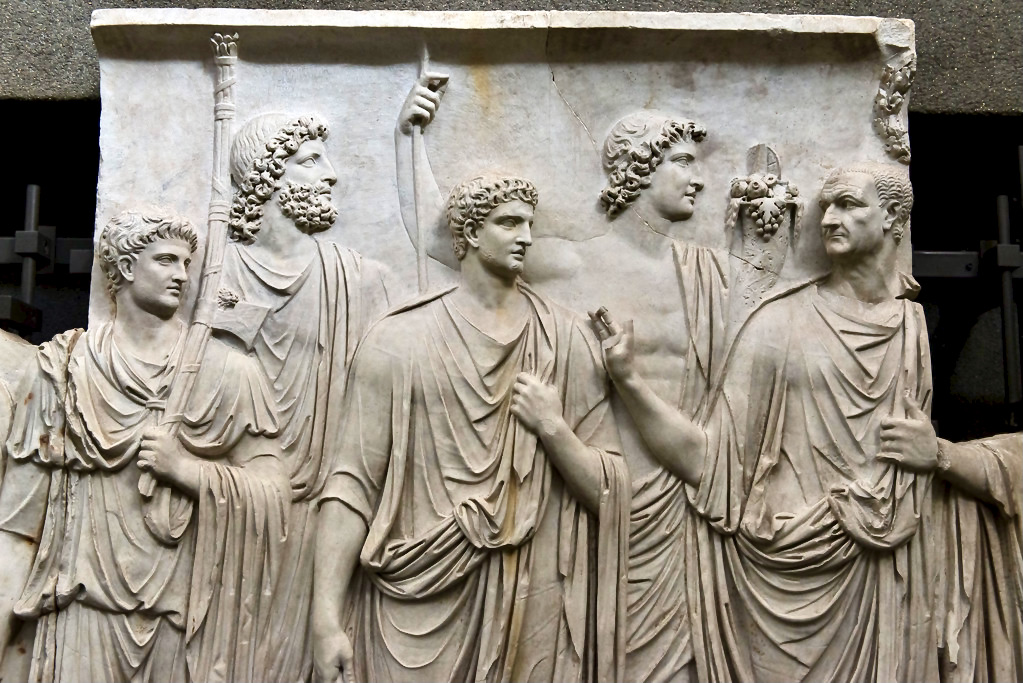
16. Reliefs From Palazzo Cancellaria, Gregory Profano Museum
These Vatican classical reliefs were discovered beneath the Palazzo della Cancelleria in 1930. They were likely once in the Roman Forum.
But the reliefs were re-carved and then discarded when Emperor Nerva died just fifteen months into his reign.
The reliefs depict mythological and allegorical figures celebrating members of the Flavian dynasty.
They were likely a piece of imperial propaganda commissioned by Emperor Domitian to exalt his family. We know this because Domitian is the central figure in the reliefs.
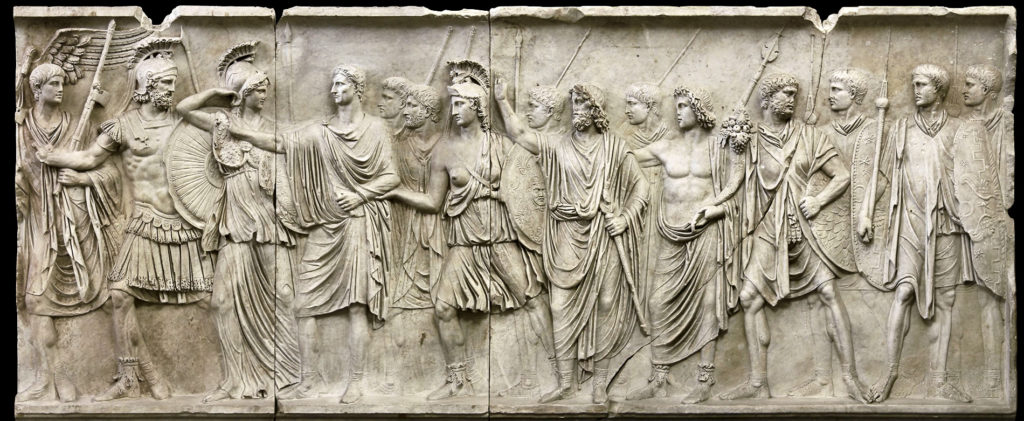
Relief A shows the arrival (adventus) of Emperor Vespasian in Rome after a victory in Palestine. He’s greeted by a man wearing a toga, most likely his son, Domitian. The entry of a ruler into Rome was always a special event.
Relief B shows the departure (profectio) for a military campaign. Emperor Domitian appears with the gods Mars, Minerva, and Roma. On the left, the wing of a Victory is visible, alluding to the success of the venture.
When the senate damned Domitian’s memory, the face of Domitian was re-carved to represent Emperor Nerva. Nerva’s face looks odd, way too small for the body to which it’s attached. Perhaps that’s why the reliefs were tossed out.
17. Bernini, Plaster Busts and Angels, 1657
The Vatican Pinacoteca holds the Vatican’s collection of easel paintings. But in Room 17, you’ll find preparatory plaster models created by the great Baroque sculptor Gian Lorenzo Bernini.
One plaster and wire cast was used to create the massive angels for the Baldachin in St. Peter’s Basilica. Two busts and other angels were used on the Chair of St. Peter.
The busts are of St. John and St. Athanasius. They’re about 4 feet tall. The angels are 8 feet tall. They look massive in the museum and very small on the basilica sculptures.
READ: Guide To Bernini’s Art in Rome
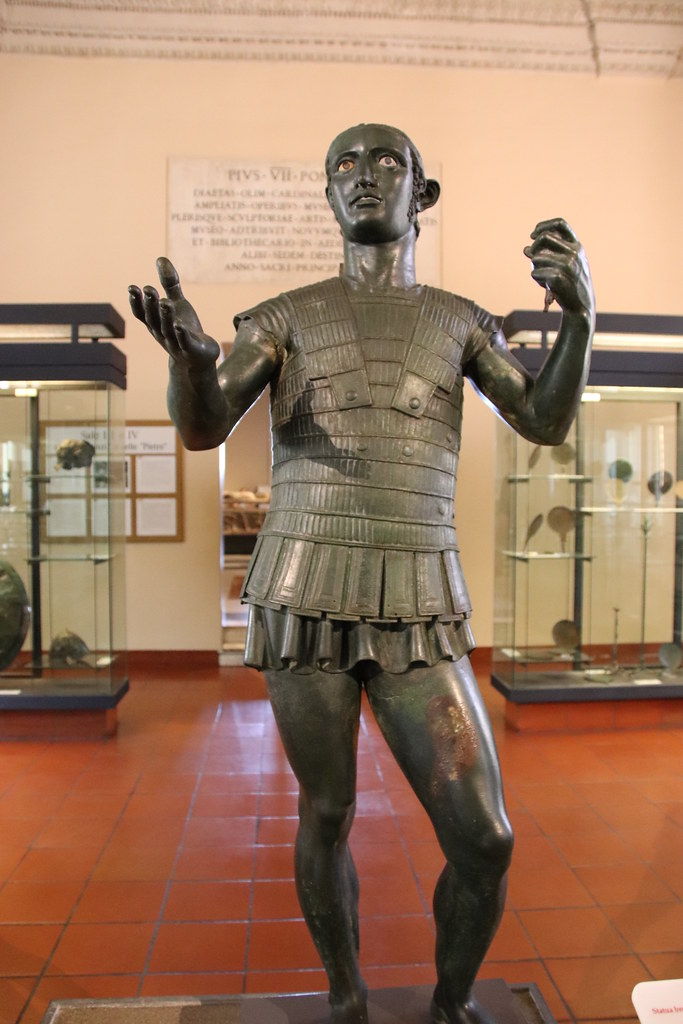
18. Mars of Todi, Gregorian Etruscan Museum
Mars of Todi is an Etruscan sculpture in the Vatican Museums. It’s an extremely rare bronze depicting a warrior in armor. The nearly life size statue was found in the Umbrian town of Todi. It only survived because, after being struck by lightning, it was buried in a stone lined coffin
Dating from the 5th century B.C., Mars of Todi is one of the largest Etruscan statues in history. The sculpture is notable for its lifelike quality and realistic musculature.
The warrior stands in a classic contrapposto pose. He appears about to speak. He originally held a spear, which is exhibited separately.
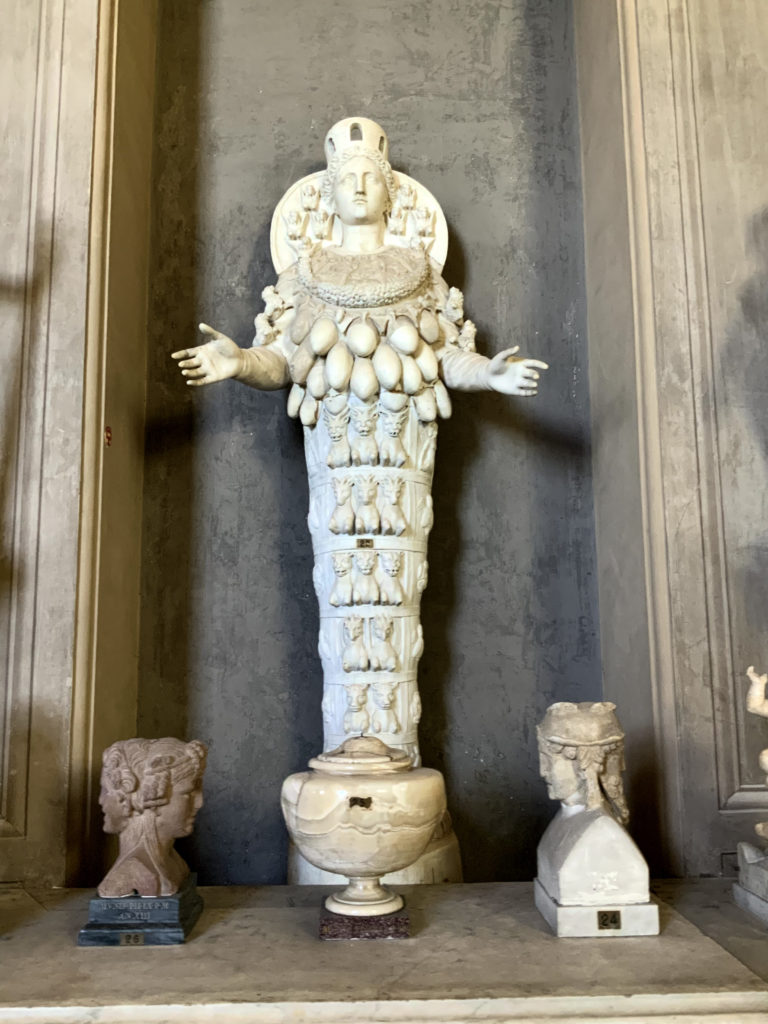
19. Artemis of Ephesus, Gallery of the Candelabra, Pio-Clementnine Museum
This version of Artemis of Ephesus was found at Hadrian’s Villa. Artemis was the daughter of Zeus and Leto. She was the Greek goddess of hunting and animals.
This Roman statue reproduces the cult iconography of Artemis, when she was avidly worshipped in the famous sanctuary at Ephesus.
Artemis is shown as the “Lady of the Animals,” protector of fertility and abundance. Her upper torso is covered with what was either the severed testicles of sacrificial bulls or multiple breasts.
The work is original in its combination of Greek and Oriental elements. There were numerous Roman copies made of this cult statue.
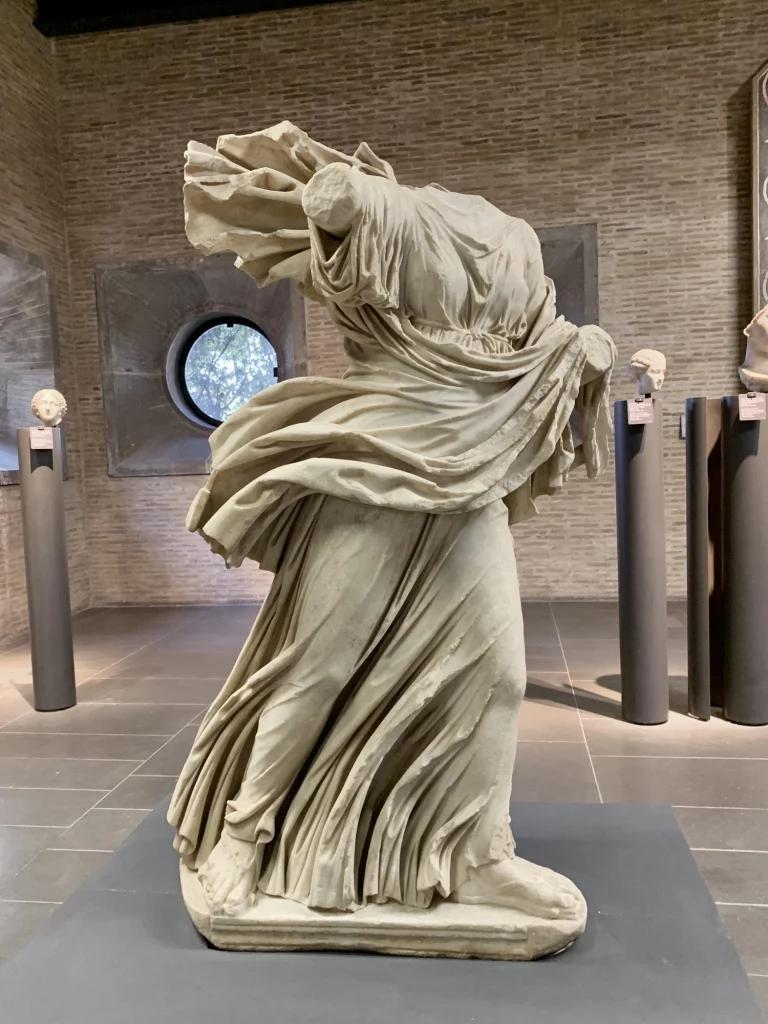
20. Chiaramonti Niobid, Gregorian Profanio Museum
This stunning sculpture in the Vatican Museums is a Roman copy of a Greek original. It depicts one of the daughters of Niobe, the Queen of Thebes. It shows the girl running to escape the arrows of Apollo and Artemis.
According to Greek myth, a fertile Niobe had 14 children. She considered herself to be superior to Leto, who only bore Zeus two children, Apollo and Artemis. The pair decide to punish Niobe for offending their mother and they kill Niobe’s children with arrows.
This figure is probably a copy of a statue from the age of Hadrian, when many group sculptures of Niobids were made. The most complete set of Niobids is housed in the Uffizi Gallery in Florence.
Like others I’ve mentioned, this work was found in the middle of the 1500s at Hadrian’s Villa.
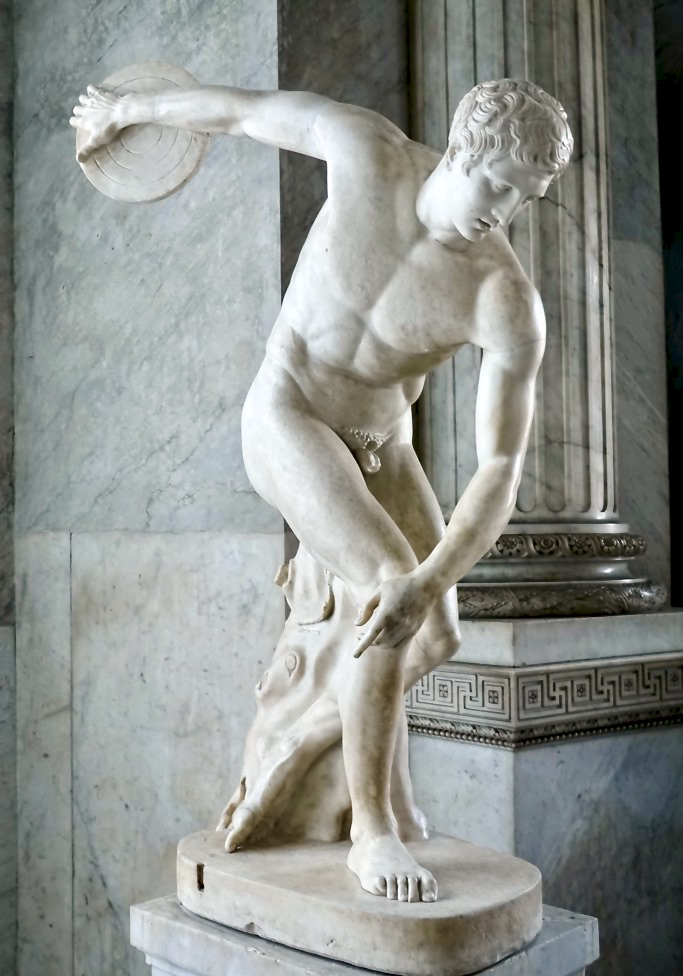
21. Discus Thrower, Pio-Clementine Museum
The Discus Thrower is a Roman marble copy of a lost Greek bronze original by the artist Myron. The young discus thrower is shown about to release his throw. The pose is considered a perfect example of harmony and balance.
Myron was the first sculptor to master this twisting style, which broke away from the rigidity of prior sculptures. As always in Greek athletics, the discus thrower is completely nude.
I hope you’ve enjoyed my guide to the famous must see sculptures in the Vatican Museums. You may enjoy these other Rome museum and travel guides:
- 5 day itinerary for Rome
- Best museums in Rome
- Archaeological sites in Rome
- Guide to the Borghese Gallery
- Guide to the Vatican Pinacoteca
- Rome’s secret palace museums
- Guide to Palatine Hill
- Guide to the Roman Forum
- Guide to the Colosseum
If you want to see the amazing sculptures in the Vatican Museums, pin it for later.
